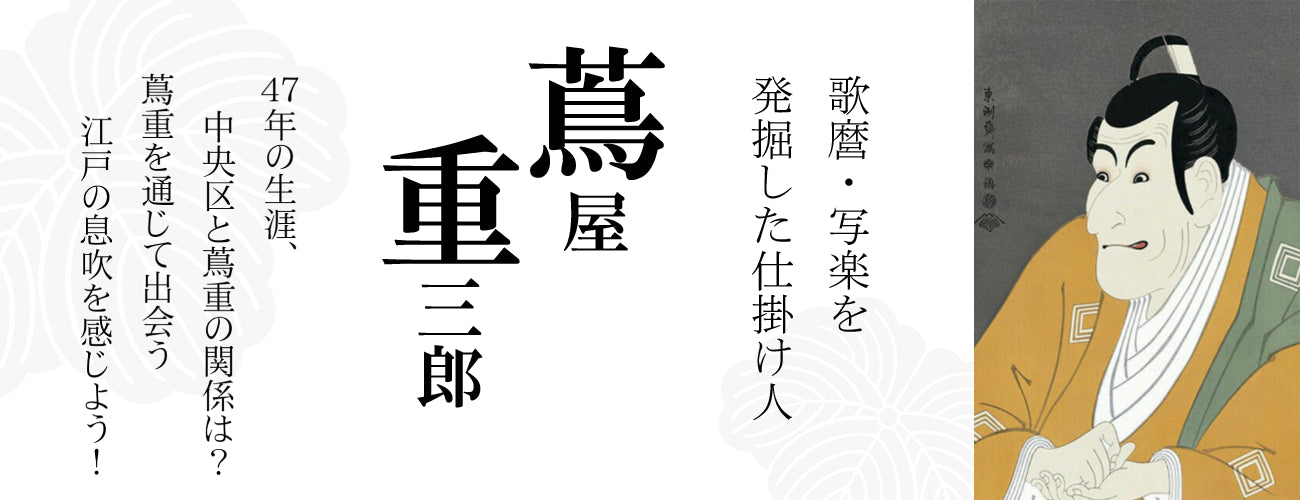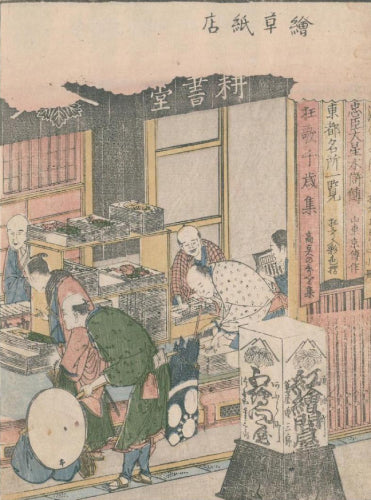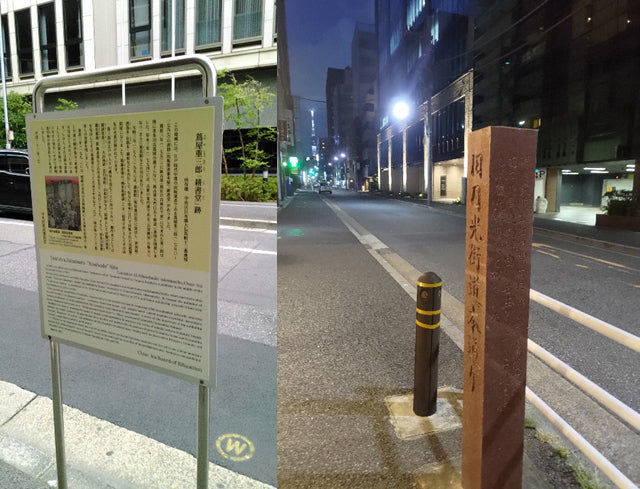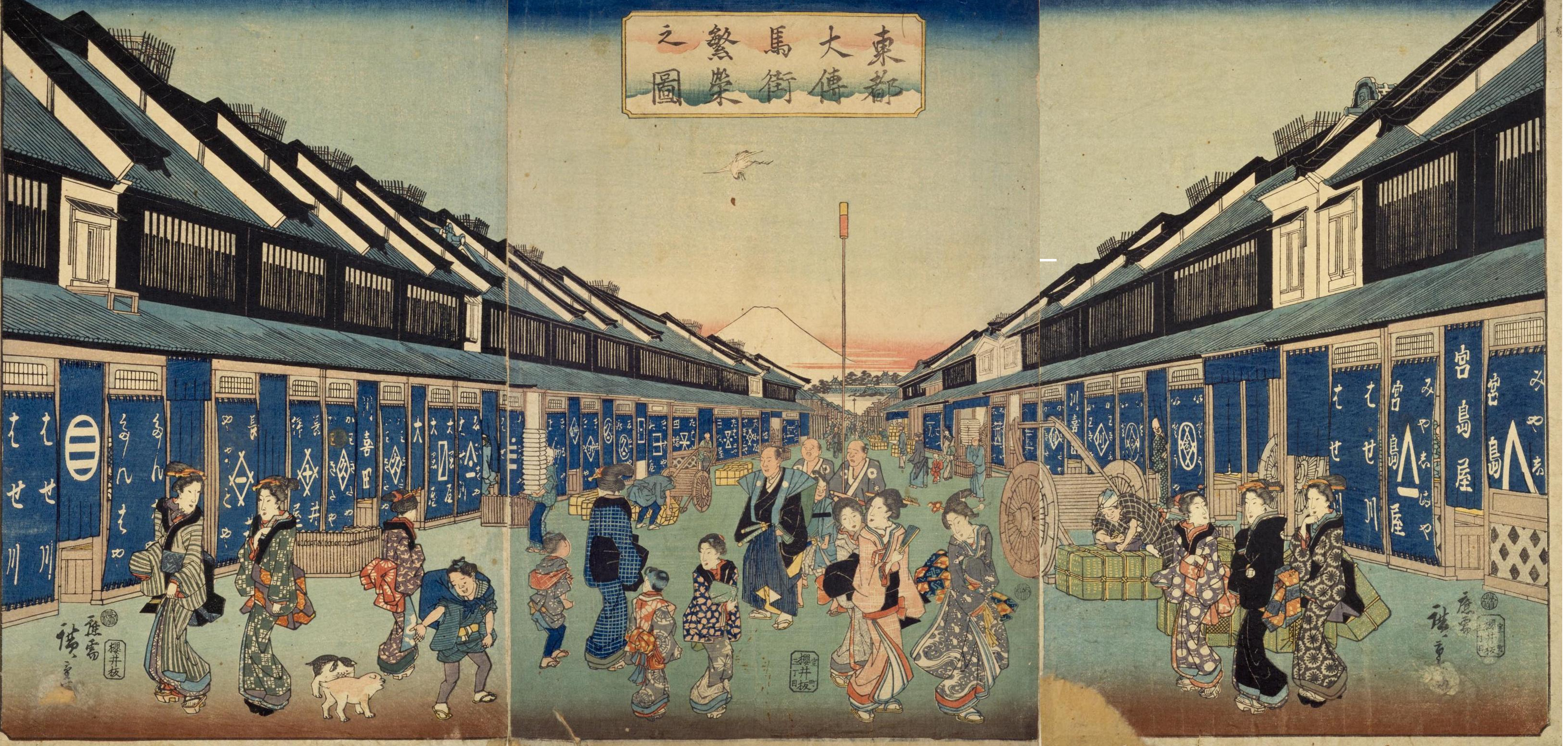JUZABURO TSUTAYA Juzaburo Tsutaya


Linked banner image to this page and above figure
Source: Sharaku Toshusai's painting "Sharaku Meigazo", Yoshifurudo, Ming 36.12. National Diet Library Digital Collection https://dl.ndl.go.jp/pid/2533724 (Reference 2025-01-23)
The content of Juzaburo Tsutaya "Tsutaju" is being updated from time to time.
We will update it as soon as the latest information arrives.


Source: Sharaku Toshusai's painting "Sharaku Meigazo", Yoshifurudo, Ming 36.12. National Diet Library Digital Collection https://dl.ndl.go.jp/pid/2533724 (Reference 2025-01-23)
His direct relationship with Chuo-ku was 33 years old in 1783 (1783).
Aiming to become the number one publisher in Edo, we will expand the new store of "Koshodo" to Aburamachi in Nihonbashi.
At that time, Tsuyu-cho connected Asakusa Hashikado from Tokiwa Hashikado to east and west, facing Honmachi, the center of Edo, facing Honmachi. This Honcho-dori St. overlaps with the Nikko Kaido heading toward Nikko and Oshu, and was also the "Onarimichi" used by the general when visiting Nikko.
Because it was a key point of transportation, it was crowded with people coming and going, and it was a main street with many shops such as cotton wholesalers and booth wholesalers. Above all, the area around Tsuyu-cho is the center of Edo's leading publishing industry, with famous publishers lined up, and Tsutashige is also expanding here.
The current Nihonbashiodenmacho, where Honmachidori is located, has a well-developed transportation network. Kodemmacho Station on the Tokyo Metro Hibiya Line, Bakuro Yokoyama Station on the Toei Shinjuku Line, Bakurocho Station on the JR Sobu Express Line, Routes 6 and 14 starting from Nihonbashi slightly north of Honmachidori, and Routes 4 runs east.
In addition, Nihonbashiningyocho, which is less than 10 minutes on foot, was a place where "Yoshiwara" was located until the Great Fire of the Meiryaku era, and was distinguished from "Shin-Yoshiwara" where Tsutashige was born.
In the Ningyocho area during the Edo period, there were playhouses in puppet ballad drama and Nakamura and Ichimura theaters in Kanji, which flourished, and I think Tsutaju also enjoyed watching the play.

(Left) Explanation board of the site of Koshodo in present-day Odenma-cho, Nihonbashi, Chuo-ku
(Right) Monument of the Old Nikko Kaido Hondori, you can see Tokyo Skytree® at the end of Honmachidori.


The state of the Great Temmacho in the late Edo period
Source: Hiroshige, "Toto Daidenma Street Prosperity Map", Sakurai. National Diet Library Digital Collection https://dl.ndl.go.jp/pid/1307610 (Reference 2025-01-24)
Please see the official website for the main character of Tsutaju, Taiga drama series "Bellabo ~ Tsutaju Sakae Kano Yume Story ~".

-

The site of "Koshodo" at Juzaburo Tsutaya Nihonbashiodenmacho
Edo's leading publisher who published works by playwrights and painters
Juzaburo Tsutaya (1750-1797) was a publisher (printer) of the Edo period and one of the leading figures of Edo culture. He opened a bookstore near Daimon in Shin-Yoshihara. In 1783, he moved to this area and opened Koshodo, a local wholesaler dealing with stylish books and ukiyo-e, etc. He published works by painters such as Hokusai, Utamaro, and Sharaku, as well as works by playwrights such as Kyoden Santo and Nanpo Ota.
※Our connection with Taiga drama series is detailed on Stella Net
Stella net -

Old Nikko Kaido Honmachidori Monument Nihonbashiodenmacho
A monument on the main street of the old Nikko-kaido Road on O Temmacho-dori Street
The Nikko Kaido, which runs from Nihonbashi, the base of the Gokaido Road, to Nikko Toshogu Shrine, is also depicted in Nishiki-e as a commercial area lined with many shops such as cotton wholesalers on the main street during the Edo period.
-

Kokumachi The Bell of Time in Jisshi Park, Designated Cultural Property
The sound of the bell that informed people of the time in Edo City
The first bell to inform people of the time of Edo Castle. It is said that it was installed in Honishi-cho (currently near 4-chome Nihonbashi Muromachi) during the era of Hidetada Tokugawa, the second shogun. The existing bell is about 170cm high and about 93cm diameter. (Earthquake-resistant construction until early August 2025)
※Our connection with Taiga drama series is detailed on Stella Net
Stella net -

Temmacho Prison Site (Designated Cultural Property) Nihonbashikodenmacho
A place to know the end of Gennai Hiraga
It is the largest prison in the Edo bakufu (Japanese feudal government headed by a shogun) over 2,600 tsubo, located around Jushi Square and Daianrakuji Temple. It can accommodate about 350 to 700 people, and was abolished in 1875 when the Ichigaya Prison was completed. In Jushi Square, a model of the state of that time is displayed.
※The connection with Taiga drama series is detailed on Stella Net.
-

Yanagibashi (Tangible Cultural Property inhabitant of a ward) Higashinihombashi
To go to Shin-Yoshiwara by boat from Yanagibashi
An iron bridge over the mouth where the Kanda River flows into the Sumida River. It began with the construction of a wooden bridge in 1698 (1698), and the current bridge was modeled on Eitai Bridge in 1929 (1929).
※The connection with Taiga drama series is detailed on Stella Net.
-

Yagenbori Fudoin Higashinihombashi
There are monuments in the precincts that originated in Kodan and Juntendo.
When Kishu Negoroji Temple was attacked by Hideyoshi Toyotomi's army, it is said that the temple's Daiin Buddhist capital descended to the eastern country to protect the statue and built a Dou on the banks of the Sumida River. During the Edo period, the fair held on the 28th of every month was crowded with many people. Ohisa Takashima, one of the three beautiful women of Kansei drawn by Utamaro Kitagawa, who specializes in beauty paintings that were found by Tsutashige, was a signboard daughter of Mizuchaya in Yagenbori, Ryogoku.
-

Nihonbashi, Kidai Shoran Nihonbashi
There is also a high-end book wholesaler on Meuki-dori Street in Edo.
The famous bridge "Nihonbashi" is the starting point of the Gokaido Road. Goods are transported from all over the country through land and rivers, and many shops gather to prosper as a center of commerce, and there are still many long-established stores that continue to be continuous. At the concourse of Mitsukoshimae Station underground on Chuo-dori, the emakimono “Kidai Shoran”, which shows the bustle of the time, is displayed, and you can also find a book wholesaler!
※The connection with Taiga drama series is detailed on Stella Net.
-

The site of Hiroshige Utagawa residence, Kyobashi
A place where popular ukiyoe artists lived for about 10 years
Hiroshige Utagawa (Ando), a ukiyo-e artist in the late Edo period, became famous for his series of poetry-rich landscape prints, and opened a new ground in flower and bird paintings. Representative works include "53rd Tokaido" and "100 famous sights of Edo". It is said that he spent about 10 years in Ogamachi (now Kyobashi) from 1849 (1849), and an explanation board is installed at the site of the house.
-

Kyobashi, the main pillar of Kyobashi
The place where Kyoden Santo (Masanobu Kitao) opened Kyoya
Kyobashi is the second bridge on the Tokaido road leading to Kyoto, after Nihonbashi. Currently, three stone pillars are left on the sidewalk of Chuo-dori.
Kyoden Santo (Masanobu Kitao) opened a cigarette shop in Shinryogaecho (now Ginza 1-chome) on the south side of the bridge.※The connection with Taiga drama series is detailed on Stella Net.
-

The site of Kano Gajuku Ginza
Shimoyashiki where Okitsugu Tanuma spent his last year
This is the place where Norinobu Kano, a painter who Okitsugu, moved to this area on the southwest corner of Tanuma's residence and opened a painting school. The Kano family of the Kano Yotsuya Kano, who was a painter in Edo shogunate.
※The connection with Taiga drama series is detailed on Stella Net.
-

Explanation of Sharaku, a mysterious painter excavated by Tsutaju, Kameshima Bridge
Sharaku Toshusai lived in Hatchobori
It is widely believed that Sharaku was the Noh actor Jurobe Saito, who held the Hachisuka family in Tokushima feudal lord, and it is said that there was a residence of Sharaku at the end of Jizo Bridge in the Edo period. There is an explanation board at the base of Kameshima Bridge.
-

Hoitsu Sakai Tomb (Designated Cultural Property, capital) Tsukiji Honganji Temple
He was the founder of the Edo Rinpa school who was in the Kyokaren (Kyokaren) like Tsutashige.
Hoitsu Sakai was a painter who was active in the late Edo period and was the founder of the so-called Edo Rinpa school. Born in Kanda as a child of the Sakai family in Himeji feudal lord, he showed his talent in haikai and painting from a young age. As a kyoka poet, he belonged to the same Kyokaren as Tsutaju. After he died, he was buried in Tsukiji Honganji.
-

Akashicho (Designated Cultural Property, capital of Kyoto)
"Dismantling Shinsho" was published by Suharaya.
Ryotaku Maeno, a feudal physician and a Dutch scholar of the Okudaira family of the Nakatsu clan in Buzen Province (now Oita Prefecture), gathered at Nakayashiki with Genpaku Sugita, Junnan Nakagawa, Hoshu Katsuragawa, and worked on translation of the Dutch medical book "Tahhel Anatomia" and published a "Dismantling New Book". There is a stone monument where the Nakatsu clan Nakayashiki in Tsukiji Akashicho was located.
※Our connection with Taiga drama series is detailed on Stella Net
Stella net -

Jippensha-Ikku Tomb (Citizen's Historic Site) Kachidoki
Tombs and monuments of a popular writer who wrote "Tokaido Nakatsune Kurige"
The tomb of Jippensha-Ikku, the creator of the best-selling "Tokaido Nakaza Kurige", is located in Shinensan Toyoin in Kachidoki. He was born in a samurai family in Sunpu, and went to Edo in 1794 (1794) to become a writer, but he seemed to be living at Tsutashige in the Lower Age. -

Ishikawajima Lighthouse Ruins Tsukuda Park
Ishikawajima Hitoshiyoroba
This is a detention facility where Tokugawa shogunate's Sadanobu Matsudaira was located on Ishikawajima and Tsukuda Island for rehabilitation and rehabilitation while serving as laborers. Later, a nightlight was built, and the Ishikawajima Lighthouse was installed to ensure the safety of ships.
※The connection with Taiga drama series is detailed on Stella Net.
-

Jushi Square Tsutashige Gallery Jushi Square Main Building 2F Alumni Association Room
Enjoy the “now” of Edo Nihonbashi
You can visit the exhibits created by volunteers gathered at the Tsutashige Study Meeting, which is regularly held by the local town council, as well as materials related to Tsutashige, such as ukiyo-e and yellow cover, free of charge.
-

[Extra Edition] Nihonbashi History Archives Green Terrace Tokiwa 1F Gallery
400 years in the Nihonbashi area and the future
This is a free gallery that conveys the tradition and present of Nihonbashi through maps, visual images, and interviews with local people. You can search on a map where there were famous publishers such as Koshodo as well as Suharaya!


-

Iba Senukiyo-e Museum
Certified facility in Chuo-ku Machikado Exhibition Hall. "Ibasen" is a long-established fan that was founded in 1590. In addition to purchasing Ukiyo-e fans and fan fans, various projects such as materials that were the publisher of Ukiyo-e are also on display.
-

Ozu Historical Museum
Certified facility in Chuo-ku Machikado Exhibition Hall. A long-established store of more than 370 years that has opened a paper merchant in Temmacho, Edo (now Ozu Washi) since 1653, long before the Tsutashige era. Many valuable historical materials such as paper and the history of the shop are displayed in the museum.
-

Jutama Bunko Gallery
Haibara is a Japanese paper shop. The first generation was founded in 1806 by Sasuke, who served at the book wholesaler "Suharaya Shigerubei". In particular, "Gosekishi" is famous, and the names of "Gosekishi Haibara" and "Birth of stationery" spread throughout Edo, including the stationery. Materials are also open to the public in the store as a certified facility for the Chuo-ku Machikado Exhibition Hall.
-

Edoya's brush exhibition hall
Edo brush specialty store, which is a manufacturer and distributor of brushes and prints in 1718, with a shop on Honmachidori. Certified facility in Chuo-ku Machikado Exhibition Hall.
The building protects the signboard architecture of the Taisho era and is designated as a national registration Tangible Cultural Property.
-

Ichimouth Tagen Kimono wholesaler Museum Juzaburo Tsutaya "Koshodo" reproduction
A museum that has been certified as a town corner exhibition hall in Chuo-ku. Founded in 1816. In addition to viewing the historical exhibits of kimono wholesalers for more than 200 years, Juzaburo Tsutaya "Koshodo" has been reproduced for a limited time! In addition, you can consult anything about kimono.
-

Watanabe Woodcut Print Exhibition Hall
Certified facility in Chuo-ku Machikado Exhibition Hall. A shop that has a large selection of Japanese woodblock prints, from original Ukiyo-e prints and reprinted Ukiyo-e prints to modern creative prints. It is very popular for celebration items and souvenirs from overseas. In the exhibition space, you can learn about the process of printing from tools used for woodblock prints.
-

Kyo Hashiman Tsugane Kinyosha Printing Plant
You can immerse yourself in the remnants of Edo culture, such as paper products based on "town fire extinguisher", "giboshi", and "Bamboo Riverside", which are closely related to Kyobashi and Nihonbashi, the towns since Edomachi fire extinguisher Nishiki-e Morooka Tachika. The drama tie-up "Marugoto Meguricho" is also full of ingenuity!
-

[Extra Edition] Tsutashige x Nihonbashi "Come to Koshodo"
A special venue for the Koshodo Project, which was established at the Nihonbashi Information Center (COREDO Muromachi 1 basement floor).
You can send information related to Tsutaju in the area, purchase Koshodo goods, ukiyo-e goods, and souvenirs from the area participating in the project.
-

[Extra Edition] Chuo-ku Tourist Information Center
In addition to providing multilingual tourist information and tourist pamphlets inside and outside the city, we also set up special corners according to the season, casual experiences, and rent wheelchairs and strollers.
A Tsutashige corner has been set up for a limited time, and related information inside and outside the city is also provided.


-

[Ningyocho Street Walking Tour] The stage of Taiga drama series broadcast in 2025-Let's walk through the city of Juzaburo Tsutaya-Customer exclusive! Private Tour by "Tourist Hospitality Staff"| Tokyo Chuo-ku History and Sightseeing Street Walking Tour
Chuo-ku "Dori" that passed the Chuo-ku sightseeing certification! The sightseeing hospitality staff will guide you while talking in detail. We will not be together with other groups, so you can enjoy it at your own pace.
-

Publishing Culture in Edo and Nihonbashi
- Juzaburo Tsutaya and its surroundings - September 25 (Thu) - November 9 (Sun), 2025Introducing the publishing culture of Edo, which flourished in the Nihonbashi area, centered on the first Juzaburo Tsutaya. A gallery talk by cultural property investigators will also be held during the period!
Period ※Partial exhibition change
[First term] September 25 (Thu) to October 15 (Wed)
[Later term] October 17 (Fri) to November 9 (Sun)
Time 9:00~17:00
※Friday until 19:00
Location: Local Museum Planning gallery space (2nd floor of Honnomori Chuou)
Gallery Talk (about 30 minutes):
・October 3 (Fri) 15:00~
・Friday, October 17 15:00~
・November 9 (Sun) 10:00~, 13:00~, 16:00~
※Approximately 20 people each time (first come, first served on the day)
Please come directly to the venue on the day. -

Taiga drama series Talk Show in Chuo-ku Wednesday, October 1, 2025
We welcome Saki Takaoka, who plays Tsutashige's mother, Tsuyo at Taiga drama series's "Bellabo ~ Tsutashige Sakae Kano Yume Story ~" (NHK), and will talk plenty about the highlights of the drama and behind the scenes!
Date and time: Wednesday, October 1 6:00 p.m.
Opening Venue: Ginza Blossom Hall
Capacity: 850 people (lottery if there are many applicants)
Application deadline: Until 11:59 p.m. on September 7th
[Organizer] Executive Committee of Chuo-ku and Chuo-ku Tourism and Commerce Festival[Co-sponsored] NHK Metropolitan Area Bureau
-

"Ukiyoe stamp rally"
Tsuta Shigehi Motohashi Project July 2, 2025 (Wednesday) - March 31, 2026 (Tuesday)stamp rally completes a ukiyo-e painting by stacking stamps at six points in Nihonbashi on a single mount.
If you collect the 6th edition, a beautiful ukiyo-e will be completed.
Stamp spot
・Ichimouth Tagen
・Jushi Square Tsutashige Gallery
・Taro Shobo
・Tsuta Shigetsuyucho Gallery
・Nihonbashi Information Center
・Nihonbashi History Archives (in alphabetical order / title omitted)
Organizer: Daidenma-cho Ninobe-cho Association -

Digital stamp rally “Tsutashige and Nihonbashi” – July 2, 2025 (Wednesday) – March 31, 2026 (Tuesday)
This is a digital stamp rally limited to the Nihonbashi area where you can collect stamps while visiting famous places in Edo in Nihonbashi and participate in a lottery where you can win various products according to the number of stamps earned.
Please refer to here for the stamp spot.
Organizer: Ningyocho Sanchome Nishi-cho Town Association
※Digital stamp rally participation requires installation of the "Furari" app. -

“UKIYOE HUNT”
Tsuta Shigehi Motohashi Project August 2, 2025 - March 31, 2026 (Tuesday)Let's find a ukiyo-e in the city while walking around the city!
Please refer to the map of the details page.
Organizer: Daidenma-cho Ninobe-cho Association -
Taiga drama series "Bellabo ~ Tsutashige Eikano Yume Story ~" Panel exhibition at Honnomori Chuo June 23 (Mon) - July 11 (Fri), 2025
※It's finishedA panel exhibition will be held at Book Forest Chuou where you can experience the world view of Taiga drama series's "Bellabo ~ Tsutashige Sakae Hanano Yume Story".
・Program introduction panel
・Cast Visual Roll Banner Exhibition
・Photo corner where you can shoot in the background of the world of "Bellabo"
・Program PR videos, etc.
Organizer: Chuo-ku Board of Education, NHK Metropolitan Area Bureau
Period June 23 (Mon) to July 11 (Fri)
Time (Mon-Sat) From 9:00 to 21:00
(Sun) From 9:00 to 17:00
※Monday, June 23 starts at noon, and June 28 (Sat) and Friday, July 11 ends at 15:00 -
Berabo Festival in Nihonbashi July 4 (Fri) - 6 (Sun), 2025
※It's finishedThe stage of the story will be held in Nihonbashi!
This is an event where you can experience the world view of the drama, and fans of the drama and those who have never seen the drama yet can enjoy it.
・"Ukiyo-e Illustration" installation with a scene from a drama in a ukiyo-e style
・Photography Props Exhibition
・Cast Visual Banner Exhibition
・Ukiyo-e-style stamp experience
・Highlight Digest VTR screening, etc.
Organizer: NHK Metropolitan Area Bureau
Period July 4 (Fri) to 6 (Sun)
Time 11:00~20:00 ※The last day ends at 19:00
Venue: Fukutoku no Mori
※Free admission and free
※It may be canceled due to stormy weather etc.




-

Introduction of Related Correspondent Blog
Introducing a blog about Juzaburo Tsutaya
-

-
Taiga drama series "Berabo ~ Tsutashige Eika no Yume Story ~"
Broadcast on NHK General, BS, BSP4K from January 5, 2025 (Sunday).
In addition, articles about Chuo-ku are:
It's in Stella net.








